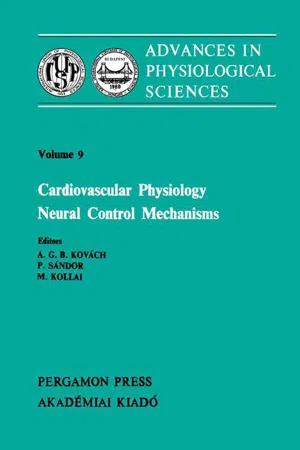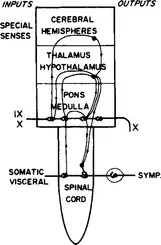
eBook - ePub
Cardiovascular Physiology Neural Control Mechanisms
Proceedings of the 28th International Congress of Physiological Sciences, Budapest, 1980
- 394 pages
- English
- ePUB (mobile friendly)
- Available on iOS & Android
eBook - ePub
Cardiovascular Physiology Neural Control Mechanisms
Proceedings of the 28th International Congress of Physiological Sciences, Budapest, 1980
About this book
Cardiovascular Physiology Neural Control Mechanisms contains the proceedings of the symposia of the 28th International Congress of Physiology held in Budapest between 13 and 19 of July, 1980. Organized into six parts, this book begins with an elucidation of the integrative role of the autonomic nervous system in the regulation of cardiovascular function. Parts II and III explain neural reflex control of the heart and cerebral blood flow regulation. Nervous control of the microcirculation and control of vascular capacitance in man and animals are then discussed. The last part focuses on the reflex control of the circulation in man.
Frequently asked questions
Yes, you can cancel anytime from the Subscription tab in your account settings on the Perlego website. Your subscription will stay active until the end of your current billing period. Learn how to cancel your subscription.
No, books cannot be downloaded as external files, such as PDFs, for use outside of Perlego. However, you can download books within the Perlego app for offline reading on mobile or tablet. Learn more here.
Perlego offers two plans: Essential and Complete
- Essential is ideal for learners and professionals who enjoy exploring a wide range of subjects. Access the Essential Library with 800,000+ trusted titles and best-sellers across business, personal growth, and the humanities. Includes unlimited reading time and Standard Read Aloud voice.
- Complete: Perfect for advanced learners and researchers needing full, unrestricted access. Unlock 1.4M+ books across hundreds of subjects, including academic and specialized titles. The Complete Plan also includes advanced features like Premium Read Aloud and Research Assistant.
We are an online textbook subscription service, where you can get access to an entire online library for less than the price of a single book per month. With over 1 million books across 1000+ topics, we’ve got you covered! Learn more here.
Look out for the read-aloud symbol on your next book to see if you can listen to it. The read-aloud tool reads text aloud for you, highlighting the text as it is being read. You can pause it, speed it up and slow it down. Learn more here.
Yes! You can use the Perlego app on both iOS or Android devices to read anytime, anywhere — even offline. Perfect for commutes or when you’re on the go.
Please note we cannot support devices running on iOS 13 and Android 7 or earlier. Learn more about using the app.
Please note we cannot support devices running on iOS 13 and Android 7 or earlier. Learn more about using the app.
Yes, you can access Cardiovascular Physiology Neural Control Mechanisms by A. G. B. Kovách, P. Sándor, M. Kollai, A. G. B. Kovách,P. Sándor,M. Kollai in PDF and/or ePUB format, as well as other popular books in Medicine & Anatomy. We have over one million books available in our catalogue for you to explore.
Information
INTEGRATIVE ROLE OF THE CENTRAL NERVOUS SYSTEM IN CARDIOVASCULAR CONTROL
P.I. Korner, Baker Medical Research Institute, Melbourne, Australia 3181
Publisher Summary
Circulation is a hydraulic regulator in which the heart adjusts cardiac output through intrinsic mechanisms determined by cardiac filling, afterload and inotropic state. In the peripheral circulation, the local autoregulatory properties of the regional beds adjust blood flow to each organ’s metabolic needs. This chapter illustrates a flow diagram that shows the major components of the circulatory control system. An optimum operation of CNS autonomic mechanisms involves a large number of integrations through neuron groups that are widely distributed from cortex to spinal cord. Noradrenergic and serotonergic neurons are a part of the network, but there are probably many other types of transmitters involved in the autonomic pathways. Anesthesia often distorts the integrative capacity of the CNS. During environmental disturbances, there are often changes in many peripheral receptors. Interactions that alter the properties of the arterial baroreflex have particular homeostatic importance as they can greatly alter the capacity of the body to correct for large circulatory perturbations.
Introduction
The circulation is a hydraulic regulator in which the heart adjusts cardiac output through intrinsic mechanisms determined by cardiac filling, afterload and inotropic state. In the peripheral circulation, the local ‘autoregulatory’ properties of the regional beds adjust blood flow to each organ’s metabolic needs. The flow diagram in Fig. 1 shows the components of this system important in overall circulatory control. A disturbance through its direct local effects on heart and vasculature will produce changes in arterial, cardiac and pulmonary pressures which are signalled to the CNS through the different groups of baroreceptors. This information together with changes in many other sensory modalities activates many regions in the CNS. The important difference of the closed-loop operation of this control system is the variety of sensory information it receives, contrasting with the classic open-loop analysis of cardiovascular reflexes where the activity of all inputs except that under study are maintained onstant or eliminated (1). The information reaching the CNS evokes a pattern of autonomic effector activity that is characteristic for the particular stimulus profile. These autonomic effects together with the direct local effects of the disturbance determine the final circulatory response.

Fig. 1 Major components of circulatory control system.
Autonomic activity may also be initiated by the CNS instead of being evoked primarily from peripherally determined information. Highly characteristic autonomic patterns may be part of a voluntary motor act or can occur, in association with different types of behaviour (2). In the event, each type of autonomic response in the intact organism is determined by both reflex and behavioural factors. Thus disturbances starting primarily owing to changes in activity in peripheral receptors also alter behaviour which may modify the autonomic response (3). In turn changes in autonomic activity initiated by central ‘command’ will alter intravascular pressures and the activity of peripheral receptors which will again influence the autonomic response (2,3).
In this lecture I have limited discussion to integrations of autonomic responses evoked primarily from peripherally determined inputs, mainly because they are more readily subjected to quantitative study than behaviourally determined changes in autonomic function. The first part of the lecture considers the major design features of the CNS autonomic pathways. Even the simplest autonomic response is mediated through numerous integrative sites. Furthermore, the sympathetic nervous system is not just a system for uniform mass action, as was at one time envisaged by Cannon (4). Instead, its activity is often non-uniform, with an increase in some outflows and a decrease in others. Another aspect briefly considered is the number of different chemical transmitters linking the various components of the autonomic network (e.g. noradrenergic and serotonergic neurons). Parenthetically, anaesthesia can distort considerably the normal operation of this system.
The second part of the lecture considers the special problems of input-autonomic output relationships in the intact organism where the CNS is presented with a complex input profile. The autonomic responses frequently appear anomalous and are difficult to predict from classic reflex analysis as the sum of the individual reflex effects. Such non-linear behaviour is often due to interactions in the CNS and its main feature is that a given autonomic response to unit change in one input becomes markedly altered by the level of activity in one or more of the other inputs. Examples considered here are chemoreceptor-ventilatory interactions and CNS ‘resetting’ of arterial baroreceptor reflex properties. The latter can greatly modify the capacity of the circulatory control system to cope with environmental disturbances.
Organisation of CNS Autonomic Pathways
Up till 1960’s the classic cardiovascular centres of the pons and medulla were considered to have a very dominant role in the integration of reflex responses, including those arising from the arterial baroreceptors, chemoreceptors and visceral and somatic afferents (5). Brain regions such as the hypothalamus, limbic system and cortex were considered to play a role only in special regulatory tasks, e.g. exercise, temperature regulation and behaviour.
The current view considers that in the conscious intact animal, as far as we know, every type of autonomic response occurs through numerous integrations involving many parts of the brain (Fig. 2). Inputs from the heart and blood vessels reach the CNS through IX and X. cranial nerves and through spinal sympathetic afferents. They synapse to project to widely distributed integrative sites from which they project to the various autonomic motoneuron pools. There are thus elaborate connections longitudinally throughout the brain as well as links between different neuron groups at any particular level. Clearly in several of the suprapontine sites information from peripheral receptor groups must come into close contact with projections from mechanisms subserving central ‘command’.

Fig. 2 Organisation of CNS autonomic pathways
There is thus a great deal of divergence and convergence of information, so that (i) a given input projects to numerous integrative sites in different parts of the brain (6); and (ii) a given group of autonomic motoneurons receives axons from any integrative sites (7).
With the wide distribution of neuron groups throughout the CNS it is important not to overemphasize the hierarchic nature of the different integrative sites by calling them ‘higher’ or ‘lower’ centres. The network is one allowing multiple access of information at numerous levels and has many outputs. Integrations performed by bulbo-spinal mechanisms such as the tractus solitarius and its nucleus, or by the autonomic interneurons of the spinal cord appear to be amongst the most complex of the autonomic network (3).
We do not yet know enough about the anatomical connections or the exact functions of the various integrative sites. Indeed, in many disturbances we are far from clear which the various neuron groups are that contribute to production of a particular autonomic response. It is for this reason that input-output analysis is still such an important tool of analysing the properties of the control system.
Examples of Integ...
Table of contents
- Cover image
- Title page
- Table of Contents
- ADVANCES IN PHYSIOLOGICAL SCIENCES
- Copyright
- FOREWORD
- Chapter 1: INTEGRATIVE ROLE OF THE CENTRAL NERVOUS SYSTEM IN CARDIOVASCULAR CONTROL
- The integrative role of the autonomic nervous system in the regulation of cardiovascular function
- Neural reflex control of the heart
- Cerebral blood flow regulation
- Nervous control of the microcirculation
- Control of vascular capacitance in man and animals
- Reflex control of the circulation in man
- INDEX